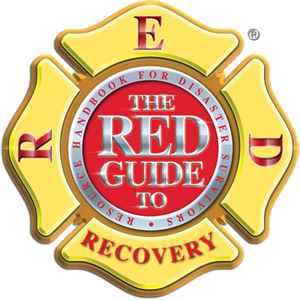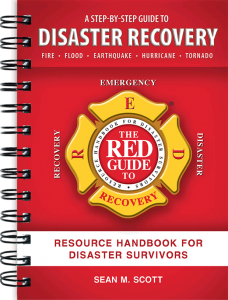Download this article and more from our free toolbox!
By Sean M. Scott & Briana C. Scott
In the fire restoration industry today, very little attention is given to the toxicity of volatile organic compounds (VOC’s), heavy metals, or the composition of particulate matter and smoke residues. Tens of thousands of toxic chemicals, gases, acids, and hazardous substances are created in structure fire settings.
Most concerns regarding toxic or hazardous substances are focused primarily on two Federally regulated materials: asbestos and lead. Typically, testing for the presence of these two hazardous materials depends largely on the age of the building, although lead and asbestos are often found in buildings built well after regulation cut off dates.
When newer homes or buildings suffer fire damage, testing for any kind of hazardous substance is typically deemed unnecessary. Occasionally, testing will be conducted for the presence of soot, char, or ash in structures near wildfire areas. However, it is almost unheard of for this type of testing to be performed to identify the composition of the combustion byproducts to determine whether the soot, char, or ash contains any hazardous substances.
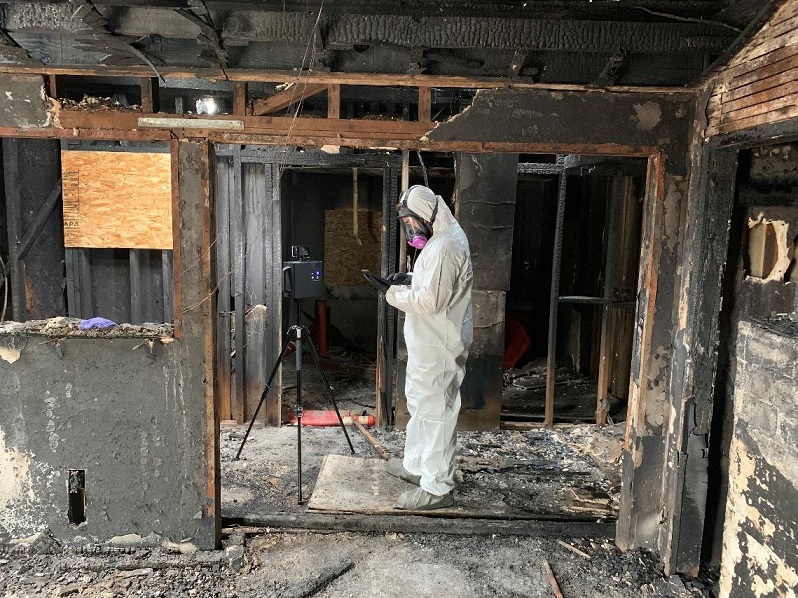 Post-structure fire and wildfire settings, especially those where plastics, synthetic materials, electronics, or household products made with polyvinyl chloride (PVC) have burned, extremely hazardous and carcinogenic chemicals are created that are typically overlooked or disregarded altogether. One chemical in particular, dioxin, some consider to be the second most toxic chemical known to man, second only to radioactive waste. [1,2]
Post-structure fire and wildfire settings, especially those where plastics, synthetic materials, electronics, or household products made with polyvinyl chloride (PVC) have burned, extremely hazardous and carcinogenic chemicals are created that are typically overlooked or disregarded altogether. One chemical in particular, dioxin, some consider to be the second most toxic chemical known to man, second only to radioactive waste. [1,2]
Not only is this substance extremely toxic to all life, and far more lethal than asbestos or lead, it is also known to the World Health Organization as a member of the so-called “Dirty Dozen” – a group of dangerous chemicals also referred to as persistent organic pollutants (POPs). [3,4]
POPs are chemicals of global concern due to their potential for long-range transport, persistence in the environment and atmosphere, ability to bio-magnify and bioaccumulate in ecosystems, as well as their significant negative effects on human health and the environment. Bioaccumulation is the accumulation of chemicals in organisms from the surrounding environment through skin absorption (by contact with contaminated surfaces, clothing, and equipment), ingestion, and inhalation.
The most commonly encountered POPs are organochlorine pesticides, industrial chemicals, and polychlorinated biphenyls (PCBs), as well as unintentional byproducts of many industrial processes, especially chlorinated dibenzo-p-dioxins (CDDs) and dibenzofurans. [5,6]
CDD’s are highly toxic compounds that are created during combustion processes, especially structure fires where PVC, plastics, paper and other chlorinated materials burn. The most toxic form of CDD is 2,3,7,8-tetrachlorodibenzo-p-dioxin (TCDD), better known simply as “Dioxin”.
What Are Dioxins and How Are They Created?
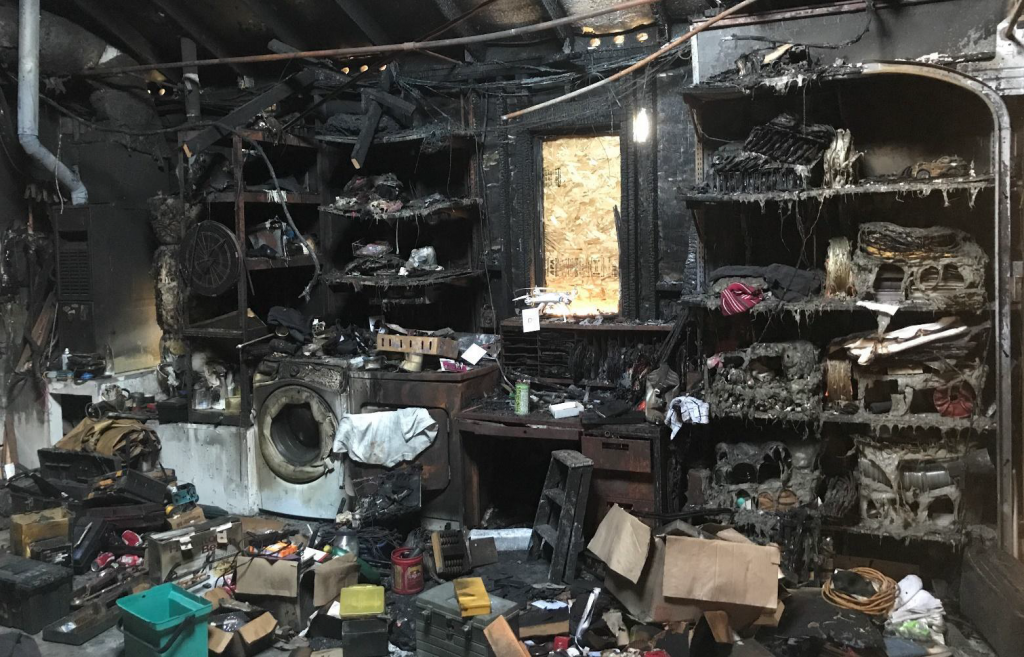
Residential garage fires typically consume large quantities of plastics, PVC, and synthetic materials.
Dioxins belong to a family of chemicals with related properties and toxicity. There are 75 different dioxins, or polychlorinated dibenzodioxins (PCDDs), 135 different furans, or polychlorinated dibenzofurans (PCDFs), and 209 different polychlorinated biphenyls (PCBs).[7] Certain dioxin-like polychlorinated biphenyls (PCBs) with similar toxic properties are also included under the term “Dioxins”. [8,9,10]
Dioxins are formed when products containing carbon and chlorine burn, especially plastic, paper, pesticides, herbicides or other products where chlorine is used in the manufacturing process. Dioxins do not typically exist in materials before they are burned. They are inadvertently produced by paper and pulp bleaching, as well as by incineration of municipal wastes. They are also especially prevalent in structure fires and wildfires.[11]
Depending on the ambient temperature in a fire, dioxins can be adsorbed or chemically bound to smoke particles or remain in a vapor phase. Adsorption is when particles bond with one another, similar to how a magnet bonds with iron, rather than being absorbed like a sponge absorbs liquids.
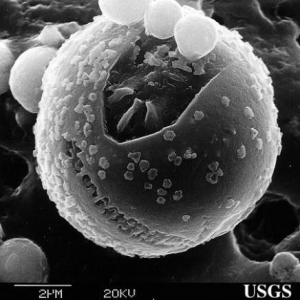
Photo Courtesy of USGS
To the left is an image of adsorption where the small white particles have adsorbed to a larger carbon particle.
According to the Environmental Protection Agency (EPA), the largest quantified source of dioxin emissions is the uncontrolled burning of household trash, referred to as “backyard” or “barrel burning”. Studies have shown that very small amounts of chlorinated materials can support dioxin formation when burning waste. [12,13]
Backyard burning of waste materials creates higher levels of dioxins than industrial incinerators. This is the result of lower heat temperatures and incomplete combustion. When TCDD is created, it is particularly dangerous because it pollutes at the ground level where it can be inhaled or incorporated into the food chain.[14]
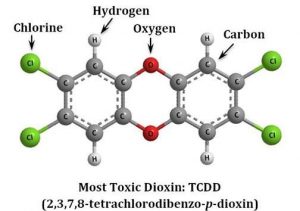 TCDD can enter your body if you inhale contaminated particulate, have skin or eye contact with contaminated soot, ash, or other materials, or eat contaminated food. [15,16] Due to the fact that ultra-fine smoke particulate matter generated in fires is often less than 3 microns in size (half the size of a red blood cell), inhalation of dioxin laden particulate can easily bypass the lungs and enter the bloodstream. [17]
TCDD can enter your body if you inhale contaminated particulate, have skin or eye contact with contaminated soot, ash, or other materials, or eat contaminated food. [15,16] Due to the fact that ultra-fine smoke particulate matter generated in fires is often less than 3 microns in size (half the size of a red blood cell), inhalation of dioxin laden particulate can easily bypass the lungs and enter the bloodstream. [17]
Smoke Webs – A Sign Of TCDD?
In structure fire settings, especially those that generate lower temperatures and a lot of smoke, there is a phenomenon often seen that is a good indication that PVC, plastics, or other synthetic materials have burned. These are commonly known as “smoke webs”. Although they look a lot like spider webs, they are actually groupings of sticky smoke particles that become ionized, which attracts them to one another and to certain surfaces. Usually these form at the corners of ceilings where smoke tends to rise and cool. Smoke webs are products of incomplete combustion and can contain a wide variety of toxic compounds, including TCDD.
The following are examples of the smoke web phenomenon from two separate structure fires where plastics and PVC burned.
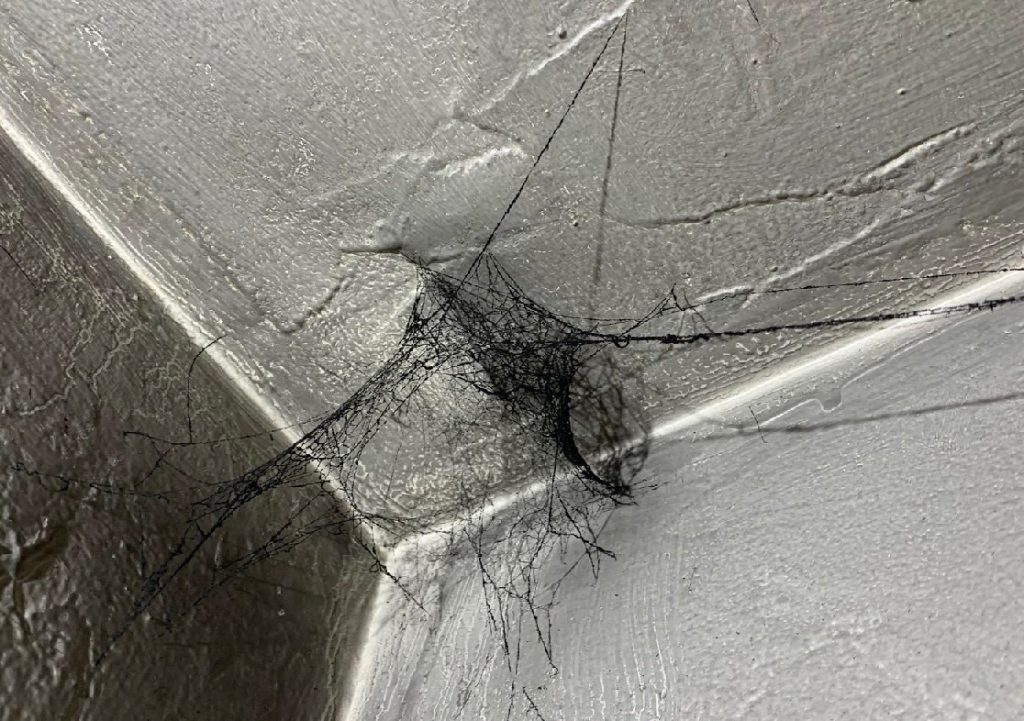
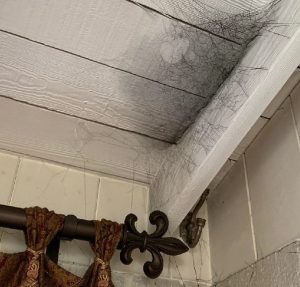
In wildfire or structure fire settings, the sheer volume of building materials, chemicals, pesticides, cleansers, automotive components, electronics, appliances, and household items manufactured with chlorinated products such as PVC, create immense amounts of TCDD. Myriads of other toxic substances are also created in structure fire settings that are too numerous to list. Unfortunately, few people realize the health risks of exposure to soot, ash, or particulate matter, and disregard the need to wear even the most basic personal protective equipment.
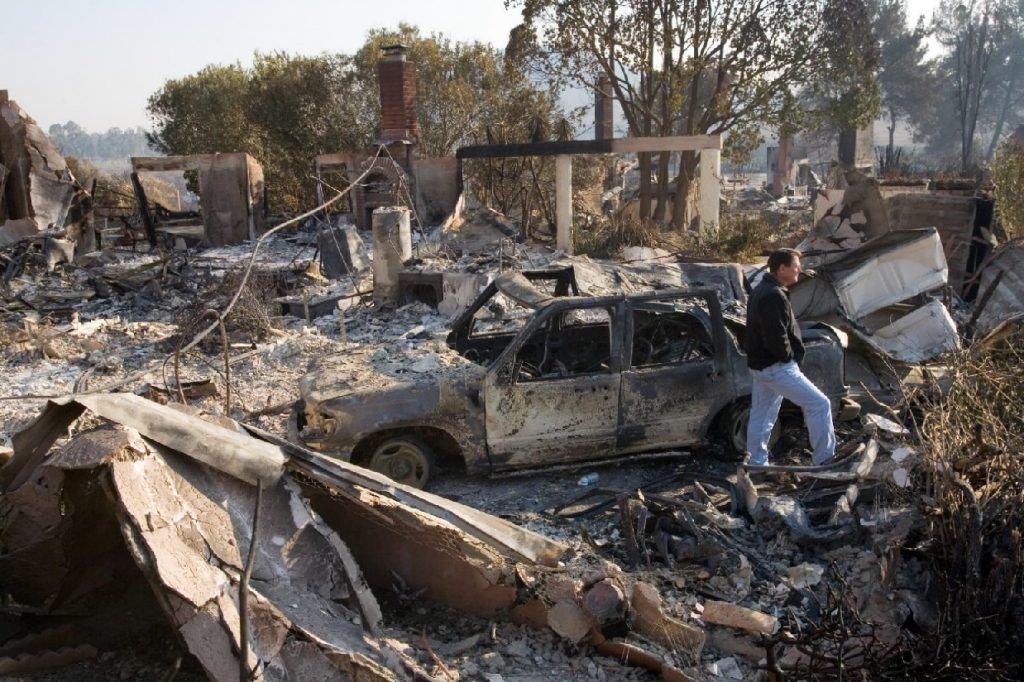
Photo courtesy of FEMA – Andrea Booheria
Human Health Risks of Exposure to TCDD
Many adverse health effects have been well documented in scientific literature regarding TCDD.
“TCDD is considered the most toxic man-made substance and the fifth most toxic naturally occurring compound known to man. 2,3,7,8-TCDD is a potent toxicant in animals and has the potential to produce a wide spectrum of toxic effects in humans (EPA 1997c)” [18,19.20,21,22]
Here are some startling facts about TCDD:
- Scientists say the toxicity of TCDD is exceeded only by radioactive waste. [23] Short-term exposure to high levels of dioxins may result in skin lesions, such as chloracne, similar to that shown on the child’s face (to the right). This child was exposed to TCDD following an explosion at a chemical plant in Seveso, Italy in 1976. Chloracne causes patchy darkening of the skin and altered liver function. Long-term exposure is linked to a vast array of diseases and ailments, including impairment of the immune system, the developing nervous system, the endocrine system, and reproductive functions.
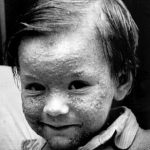 Other adverse health effects may include cardiovascular disease, diabetes, cancer, porphyria, endometriosis, early menopause, reduced testosterone and thyroid hormones, altered immunologic response, skin, tooth, and nail abnormalities, altered growth factor signaling, and altered metabolism. [24]. Diseases which have been linked to dioxin seem endless. Ingesting dioxin can also result in congenital malformations, spontaneous miscarriages, and a fatal, slow wasting syndrome similar to AIDS. Dioxin is strongly suspected of contributing to pathology of the urinary and hematological systems, growths in the colon, gallbladder complications, multiple myeloma, and lung, larynx and prostate cancer.According to researcher Joe Thornton, “Dioxin’s health effects include endocrine disruption, reproductive impairment, infertility, birth defects, lowered sperm counts, impaired neurological development, damage to the kidneys, and metabolic dysfunction. There is no evidence that there is a safe level of dioxin exposure below which none of these effects will occur.” [25]
Other adverse health effects may include cardiovascular disease, diabetes, cancer, porphyria, endometriosis, early menopause, reduced testosterone and thyroid hormones, altered immunologic response, skin, tooth, and nail abnormalities, altered growth factor signaling, and altered metabolism. [24]. Diseases which have been linked to dioxin seem endless. Ingesting dioxin can also result in congenital malformations, spontaneous miscarriages, and a fatal, slow wasting syndrome similar to AIDS. Dioxin is strongly suspected of contributing to pathology of the urinary and hematological systems, growths in the colon, gallbladder complications, multiple myeloma, and lung, larynx and prostate cancer.According to researcher Joe Thornton, “Dioxin’s health effects include endocrine disruption, reproductive impairment, infertility, birth defects, lowered sperm counts, impaired neurological development, damage to the kidneys, and metabolic dysfunction. There is no evidence that there is a safe level of dioxin exposure below which none of these effects will occur.” [25] - TCDD is an endocrine-disrupting chemical that can threaten the development of newborns. The endocrine system is a series of glands that produce and secrete hormones that the body uses for a wide range of functions, including respiration, metabolism, sensory perception, sexual development, and growth. [26,27]
- The U.S. National Toxicology Program, the International Agency for Research on Cancer of the World Health Organization, and the EPA have determined that TCDD is a proven human carcinogen. [28,29,30,31] In July 2009, the U.S. Institute of Medicine published a report that showed evidence of an association between exposure to TCDD and soft-tissue sarcoma, non-Hodgkin’s lymphoma, chronic lymphocytic leukemia, Hodgkin’s disease, prostate cancer, multiple myeloma, as well as cancers of the larynx, lungs, bronchi, and trachea. [32]
- TCDD is on the Special Health Hazard Substance List because it is a teratogen. [33] A teratogen is any agent that causes an abnormality following fetal exposure during pregnancy. Pregnant women and their developing infants are extremely vulnerable to the effects of TCDD.
- TCDD is genotoxic and a known mutagen. [34] A mutagen is a physical or chemical agent that causes a mutation, which is a change in the DNA of a cell. DNA changes caused by mutagens may harm cells and cause certain diseases, such as cancer. [35] TCDD alters the genetic structure of living cells. The effect TCDD has on cell structures and genes can be passed down to future generations. In 2012, a scientific study found that dioxin affects not only the health of an exposed rat, but also unexposed descendants through a mechanism of epigenetic transgenerational inheritance. Michael Skinner, Ph.D., a professor in the Center for Reproductive Biology at Washington State University, discovered that “exposure to dioxin caused changes in the DNA methylation patterns of sperm that were transmitted across generations to affect the health of multiple generations of descendants. The grandchildren of exposed rats showed dioxin-induced effects ranging from polycystic ovarian disease to kidney disease. Due to its extremely long half-life, dioxin may still affect pregnancies occurring even 20 years after exposure.” [36,37,38,39,40] When dioxin binds to an intracellular protein known as the aryl hydrocarbon receptor (AHR), the AHR can alter the expression, or function, of certain genes. The resulting cellular imbalance leads to a disruption in normal cell function and adverse health effects. [41] The genetic effects of TCDD may skip a generation and reappear in third or subsequent generations. [42]
- TCDD is hepatotoxic (toxic to the liver), nephrotoxic (toxic to the kidneys), and embryotoxic (toxic to embryos). [43]
- TCDD causes birth defects and spontaneous miscarriages.[44,45]
- TCDD is a highly immunosuppressive chemical that induces potent suppression of immune responses in laboratory animals.[46,47,48]
- TCDD is neurotoxic. [49] Neurotoxicity is a form of toxicity in which a biological, chemical, or physical agent has an adverse effect on the central and/or peripheral nervous system. This may include limb weakness or numbness, loss of memory, vision, and/or intellect, uncontrollable obsessive or compulsive behaviors, delusions, headache, cognitive problems, and sexual dysfunction. [50]
- The International Joint Commission, comprised of the United States and Canadian governments, has publicly stated that zero exposure to dioxin is the only safe level. There is no permissible exposure limit set by the National Institute for Occupational Safety and Health (NIOSH) [51,52]
- TCDD is bioaccumulative and becomes more concentrated with repeated exposure. Once internalized, they accumulate in body tissues, mainly body fat, resulting in chronic lifetime exposure (Schecter et al., 1994). [53,54,55,56]
- When calculating human exposures, dioxins are so toxic that they are measured in picograms—that is, trillionths (0.000000000001) of a gram. [57,58] TCDD, even in picograms, is associated with severe health damage that can shorten the lives of people exposed to it. [59]
- In 1999, the Agency for Toxic Substances and Disease Registry (ATSDR) set a minimal risk level for dioxins and related compounds of 1.0 picogram (1 trillionth of a gram) toxicity equivalence (TEQ) per kilogram of body weight per day. [60]
- In certain animal species, 2,3,7,8-TCDD is so harmful that it can cause death after a single exposure. [61]
- No antidote for dioxin toxicity is known. Symptomatic and supportive care is the only known therapy. [62,63]
More Important Facts About TCDD
- TCDD was a key ingredient in Agent Orange that was used as a defoliant in the Vietnam war. [64]
- Half-life estimates for TCDD (the time required for TCDD to decrease by half) on surface soil range from 9-15 years, whereas the half-life in subsurface soil may range from 25 to 100 years. [65]
- Dioxins persist in the environment for a long time because they do not dissolve in water. [66]
- TCDD is a solid chemical compound that has no color or odor and has the appearance of white crystalline needles. [67,68]
- Photolysis (the decomposition of molecules by the action of light) is considered to be the most important degradation mechanism of gaseous dioxins in the atmosphere. However, laboratory evidence indicates that when dioxins interact with particles, photodegradation is reduced to insignificant levels and, therefore, is too slow to provide considerable protection to the environment [Kwok et al 1995]. [69] Since TCDD is a persistent organic pollutant and can travel long distances in the atmosphere, sunlight, ozone (O3), and hydroxyl (OH) have little effect in oxidizing TCDD or removing it from the air. Sunlight and atmospheric chemicals will break down a very small portion of TCDD, but most will be deposited on land or water. [70] This indicates that the use of oxidizers in the restoration industry, such as ozone or hydroxyl, would be ineffective to remove TCDD from fire or smoke damaged structures, soft goods, or textiles.
- TCDD will decompose over time when exposed to ultraviolet light. However, the only other known way to completely destroy it is by physically removing the material it has contaminated, or by incinerating it at temperatures over 1550°F. [71]
- Due to volatilization and cold condensation properties, dioxins may be transported long distances in the global atmospheric circulation toward the polar regions of the earth. Warm air currents tend to rise, carrying the particles that vaporize easily in the warmer climates. The particles travel to the cooler climates, sinking back to earth as they arrive in the cold polar regions. Animals in cooler regions (e.g., fish such as salmon, cod, and halibut, and mammals such as polar bears, seals, and whales) tend to have high levels of body fat to insulate themselves from the cooler temperatures. Therefore, they are susceptible to bioaccumulating dioxins. [72]
- When a fire is extinguished and the air begins to cool, the dioxin-laden particles settle and become part of the soot, ash, and particulate matter. Burning 1 kilogram (2.20 pounds) of wood produces as much as 160 micrograms of total dioxins. This was determined from a test where various specimens of wood were burned in different stoves. Soot was collected and analyzed through specific, documented procedures. The highly chlorinated dioxins were the major components. In the soot from a series of experiments, their total content ranged from 10 to 167 mg/kg of fuel.
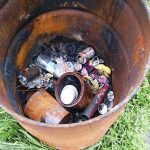
Photo Courtesy of Marshall County Solid Waste District
The total yields of TCDDs ranged from 0.1 to 7.8 mg/kg of fuel. [Science, Vol. 266 Oct. 21, 1994,T.J. Nestrick and L.L. Lamparski]. [73]
- The US Environmental Protection Agency, the New York State Department of Health, and the New York State Department of Environmental Conservation published a study in which they measured the types and amounts of many chemicals in the smoke from burn barrels (55 gallon drums used to dispose of household waste in rural areas). For some of those chemicals, burning about 10 pounds of trash per day in a household burn barrel may produce as much air pollution as a modern, well-controlled incinerator burning 400,000 pounds a day of trash. [74] The volume of toxic chemicals and pollutants, including TCDD, generated in a typical residential structure fire would be the equivalent of thousands of burn barrels.
- The State of Minnesota conducted a burn barrel study and reported that 4.0 × 10-6 mg (0.000004 mg) of 2,3,7,8-TCDD was created per kilogram of garbage fed into the barrel. The TCDD emission estimate was estimated to be greater than 5 × 10-4 mg/kg (0.0005mg) of trash consumed by combustion. [75]
- The amount of TCDD created during a structure fire where tons of wood, furniture, plastics, appliances, cars, paper and other materials burn, creates immeasurable quantities of dioxins. [76]
- In 1971, the entire town of Times Beach, Missouri was exposed to high levels of dioxins when contaminated waste oil was spread on the dirt roads in order to control dust. In the very same year, TCDD was identified as a teratogen. Then, in 1983, all properties in Times Beach were bought out by the EPA for a total of $32 million dollars. The inhabitants were relocated, the town was demolished, and 265,000 tons of regional soil were incinerated. [77]
- Barry Commoner, professor of plant physiology at Washington University, stated that “Many toxic chemicals are linked with a specific illness, such as lead and brain damage, or asbestos and mesothelioma. Others are linked with several illnesses. Dioxin is tied to such a large number of diseases because it is a cancer-enhancer. Dioxins intensify cancers which other toxins begin. They greatly enhance the activity of the enzyme system that converts most environmental carcinogens into active agents. Dioxin can stimulate the enzyme so powerfully that it sharply increases the activity of the small amounts of carcinogens present in food, water, and air, thereby intensifying their effect on tumor incidence. In effect, dioxin influences tumor production by enhancing the activity of carcinogens. This is why dioxin has different effects on different people. For example, if a group of workers has already been exposed to chemicals which cause Hodgkin’s disease, dioxin will speed up the process and they will have an increased rate of Hodgkin’s disease progression. The human body tends to store dioxin in fatty tissue, and when people take in dioxin through food or air, it ends up stored inside of their cells.” [78]
Fire damaged homes and fire debris should be treated as hazardous material. Anyone who works in or around a fire damaged structure should wear proper personal protective equipment.
TCDD and Agent Orange
During the Vietnam War, the U.S. Air Force conducted “Operation Ranch Hand”, a tactic that destroyed inland forests and coastal mangroves by spraying Agent Orange from aircrafts and helicopters.
From August 1965 to February 1971, a total of 17.6 million gallons of herbicide was sprayed over approximately 3.6 million acres of land. In addition to the aerial attacks, soldiers also sprayed herbicides on the ground from the backs of trucks to defoliate the perimeters of base camps and fire bases.
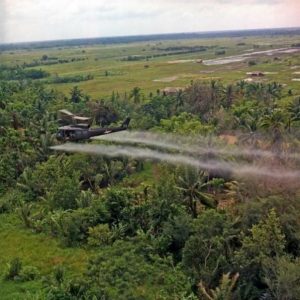
Photo Courtesy of Wikimedia Commons
The purpose of spraying these herbicides was to make it easier to detect enemy bases and movements around U.S. base camps and fire bases. It was also used to destroy the crops of the Vietcong and North Vietnamese.
Agent Orange’s active ingredients killed plants quickly and effectively. It also contained significant amounts of TCDD. TCDD was not intentionally added to Agent Orange; rather, it was a byproduct produced during the manufacturing of herbicides. In addition to the massive environmental devastation of the U.S. defoliation program, Vietnam has reported that approximately 400,000 people were killed or maimed as a result of exposure to Agent Orange. Since the war, 500,000 Vietnamese children have been born with serious birth defects, while as many as 2 million people are suffering to this day from cancer or other illnesses caused by the deadly chemical. [79,80,81] It is unknown how many future generations will suffer the effects of exposure to TCDD resulting from their ancestor’s exposure.
How Toxic is TCDD and How Does it Compare with Other Toxins?
To better understand how toxic TCDD is, one needs to understand how it and other toxins are measured. In toxicology, the median lethal dose is identified as LD50 (abbreviation for “lethal dose, 50%”). LC50 is the abbreviation of lethal concentration, 50%. These are used to measure the lethal dose of a toxin, radiation, or pathogen. The value of LD50 for a substance is the dose required to kill half the members of a tested population after a specified amount of time. LD50 figures are often used as a general indicator of a substance’s acute toxicity.
Here is a table that shows how small intake or stated exposure limits can be:
The Metric System – Weight (Mass)
| 1 Femtogram (fg) = | 0.000000000000001 gram (1 quadrillionth of a gram) |
| 1 Picogram (pg) = | 0.000000000001 gram (1 trillionth of a gram) |
| 1 Nanogram (ng) = | 0.000000001 gram (1 billionth of a gram) |
| 1 Microgram (μg) = | 0.000001 gram (1 millionth of a gram) |
| 1 Milligram (mg) = | 0.001 gram (1 thousandth of a gram) |
| 1 Centigram (cg) = | 0.01 gram (1 hundredth of a gram) |
| 1 Decigram (dg) = | 0.1 gram (1 tenth of a gram) |
| 1 Dekagram (dkg) = | 10 grams |
| 1 Hectogram (hg) = | 100 grams |
| 1 Kilogram (kg) = | 1000 grams |
To illustrate how toxic TCDD is, here are some exposure and intake limits set by different countries. This information was provided in part by The International Agency for Research on Cancer (IARC):
- The Occupational Exposure Limit for TCDD in Germany is 0.01 ng/m3 (.01 nanogram or billionth of a gram per cubic meter) for inhalation (2011) [82]
- The Occupational Exposure Limit for TCDD in Switzerland per week is 10 pg/m3 (10 picograms or 10 trillionths of a gram per cubic meter) for inhalation or skin exposure (2011) [83]
- Canada, 10 pg I-TEQ/kg/day (CDDs and CDFs)
- Nordic countries, 0 to 35 pg TCDD/kg/week
- Netherlands, 1 pg dioxin/kg/day
- Sweden, 5 pg dioxin/kg/day
- Japan, 10 pg/kg/day (CDDs and CDFs)
- World Health Organization Total daily intake 1-4 picograms per kg body weight
- Health Council of the Netherlands Health-based exposure limit, 1 picogram per day per kg bodyweight
- In 1989, the Agency for Toxic Substances and Disease Registry (ATSDR), toxicological profile for 2,3,7,8-tetrachlorodibenzo-p-dioxin report stated “Both the Centers for Disease Control (CDC) (Kimbrouh et al. 1984) and the Food and Drug Administration (FDA 1983) have calculated a virtual safe dose for 2,3,7,8-TCDD, which corresponds to an excess cancer risk of 10-6 . The FDA calculations were based on the Kociba et al. (1978 a,b) study, whereas the CDC calculations were based on the Squire evaluation of the Kociba et al. (1978 a,b) study. Thus, human intake values that correspond to an estimated 10-6 risk derived by EPA, CDC, and FDA, respectively are 6.4, 27.6, and 57.2 fg/kg/day.” The abbreviation (fg) represents femtograms, or quadrillionths of a gram, versus μg or millionths of a gram.[84]
- In 1992, the ATSDR derived a minimal risk level (oral) at 0.000001 micrograms per kg body weight per day (1×10-6 μg/kg/day)[85,86]
- In 1999, the ATSDR lowered the minimal risk level for dioxins and related compounds to 1.0 picogram toxicity equivalence (TEQ) per kilogram of body weight per day.[87]
To illustrate just how toxic TCDD is, the lethal dose of lead for humans is 450 mg/kg of body weight. [88] Using the EPA’s 1997 carcinogenicity benchmark dose of TCDD as 0.0000156 mg/kg of body weight, [89] TCDD would be approximately 28,846,154 times more toxic than lead. Methylmercury is another toxic heavy metal, which has an estimated lethal dose of about 20 mg/kg of body weight. TCDD is approximately 1,282,051 times more toxic than Methylmercury.
Here are some more comparisons of toxicity of a few well-known toxic substances and TCDD:
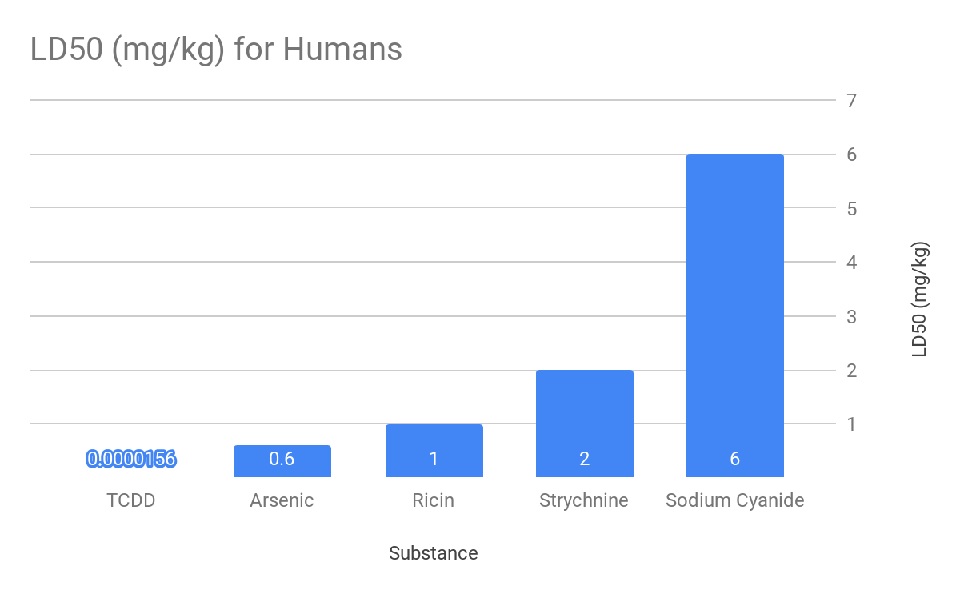 The graph above clearly shows how miniscule the lethal dose of TCDD is in comparison to other deadly chemicals. As mentioned previously, dioxins are measured in picograms—that is, trillionths (0.000000000001) of a gram. [90] It is very difficult to visualize how minute a particle at one part per trillion really is, so here are some examples of what one part per trillion (ppt) might look like:
The graph above clearly shows how miniscule the lethal dose of TCDD is in comparison to other deadly chemicals. As mentioned previously, dioxins are measured in picograms—that is, trillionths (0.000000000001) of a gram. [90] It is very difficult to visualize how minute a particle at one part per trillion really is, so here are some examples of what one part per trillion (ppt) might look like:
- One ppt would be represented by a single drop of food coloring in 18 million gallons of water.
- 1 second in nearly 32,000 years
- 1 ounce in 7.5 billion gallons of water
- The equivalent of one grain of sand in an Olympic-sized swimming pool.
Acute and Chronic Toxicity
There is a wide variation in the lethal dosage of TCDD among animal species (oral LD50 0.6-5,000 μg TCDD/kg of body weight). When a lethal dosage of TCDD is administered to experimental animals, they suffer from progressive weight loss and die several weeks later. Animals given single or repeated oral dosages of TCDD of 0.1 to 25 μg/kg of body weight demonstrated increased liver weights and lipid accumulation, thymic atrophy, and histopathological changes in liver and thymus. [91] TCDD administered to mice and rats at dosages as little as 0.125-3 μg TCDD/g of body weight induced fetotoxicity that included cleft palates, kidney anomalies, intestinal hemorrhages, excessive tissue/organ fluid (edema), and prenatal mortality. [92]
PVC – A Major Source of TCDD
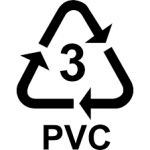 Polyvinyl Chloride (PVC) is the world’s third-most widely produced synthetic plastic polymer, after polyethylene and polypropylene. About 40 million tons are produced per year, with China being the largest producer. Approximately 70% of PVC is used in building and construction applications. [93] Polyvinyl chloride (PVC) contains toxic heavy metals including lead, mercury, and cadmium. [94,95] If a product is made with PVC, there will typically be a triangular “chasing arrows” symbol with a number 3 in the center stamped on it. The symbol would look like the image to the left.
Polyvinyl Chloride (PVC) is the world’s third-most widely produced synthetic plastic polymer, after polyethylene and polypropylene. About 40 million tons are produced per year, with China being the largest producer. Approximately 70% of PVC is used in building and construction applications. [93] Polyvinyl chloride (PVC) contains toxic heavy metals including lead, mercury, and cadmium. [94,95] If a product is made with PVC, there will typically be a triangular “chasing arrows” symbol with a number 3 in the center stamped on it. The symbol would look like the image to the left.
PVC is a prime suspect in the creation of TCDD in structure fires and is used to make thousands of building and household products. These include:
- Plumbing and irrigation pipes
- Siding
- Vinyl windows and doors
- Wire/cable insulation
- Electrical outlet and switch boxes
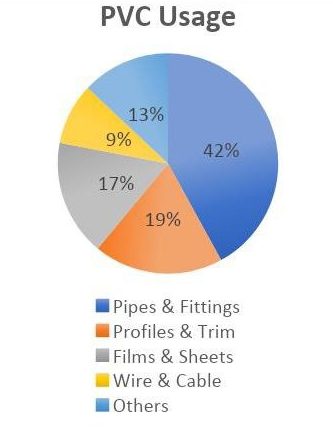
- Wallpaper
- Flooring
- Carpet backing
- Moldings
- Shutters and window blinds
- Fencing
- Lattice
- Gutters
- Garden hoses
- Tools
- Credit cards
- Phonograph records
- Audio and video tape cases
- Packaging
- Shower curtains
- Luggage
- Electronics
- Indoor furniture
- Upholstery
- Outdoor furniture
- Children’s toys
- Strollers
- Raincoats
- Rain boots
- Play structures
- Countless other household products
Who is at The Greatest Risk of Exposure to TCDD?
Firefighters
Thirty years ago, firefighters were most frequently diagnosed with asbestos-related cancers. Today, the cancers are more often leukemia, lymphoma, myeloma, oral, digestive, respiratory and urinary cancers. It is no coincidence that these are the same types of cancers known to be caused by exposure to TCDD.
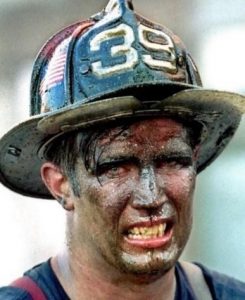
Photo courtesy of John Nee – Boston Fire Department
According to the International Association of Firefighters, cancer caused 61% of the career firefighter line-of-duty deaths from January 1, 2002, to March 31, 2017. [96] One reason for this is the fact that modern homes and buildings are full of synthetics, plastics, and chemicals that create extremely toxic smoke when they burn. This exposes firefighters to heavy concentrations of poisonous gases, acids, and TCDD-laden smoke.
Although firefighters wear state of the art personal protective equipment (PPE), toxic chemicals often find their way through where they can be inhaled, ingested, or absorbed by the skin or around the eyes. Exposure to TCDD is likely to be one of the primary causes or at least a contributing factor for the high number of cancers, diseases, and fatalities to the men and women in the fire service.
Fire Investigators
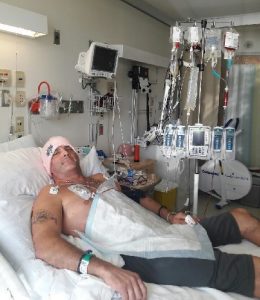
Photo courtesy of Glenn Preston – Boston Fire Department
Fire investigators typically spend hours and sometimes days inside fire damaged structures. They sift through smoldering debris and ash searching for the cause and origin of fires. Oftentimes PPE is regarded as cumbersome and not worn. Here investigators are exposed to VOC’s, high concentrations of TCDD, heavy metals, asbestos, and a myriad of other toxins in the soot and ash as well as in the airborne particulate matter.
Residents, Homeowners, and Wildfire Survivors
After a fire, residents often venture inside their homes to survey the damage, retrieve personal property, take photos, etc. In most cases, people are unaware of the dangers posed by post-fire environments and enter without any concern for personal safety or personal protective equipment. Here they are not only exposed to TCDD and other toxic contaminants in the soot, ash, and particulate, but they can also get contaminants on their clothes, shoes, and body where they can cross-contaminate their cars, workplaces, and family members.
Disaster Relief Workers and Volunteers
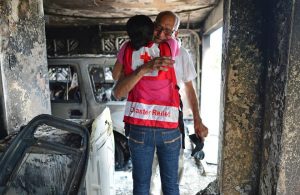
Photo Courtesy of the American Red Cross
Disaster relief workers are often exposed to TCDD and other hazardous substances in and around fire damaged structures as well. Not only does this expose them to hazardous substances, but they also can inadvertently carry TCDD-laden soot, ash, and particulate with them on their clothes. This can then cross-contaminate their cars, offices, shelters, as well as family members at home. Entry within fire damaged buildings should be avoided.
Insurance Adjusters and Restoration Personnel
Insurance adjusters and restoration contractors typically show up to fire damaged buildings shortly after fires have been extinguished. Here, they can be exposed to high concentrations of TCDD and other toxins in the soot and ash, as well as in the airborne particulate. It is commonplace for adjusters, contractors, and restoration personnel to spend long hours in or around fire damaged structures, taking photos, writing estimates, inventorying belongings, etc. All too often, PPE is disregarded, and it is all-to-common to see adjusters and contractors walking through fire debris without any PPE whatsoever. This is likely due in large part to a lack of education on the toxicity of post-fire environments.
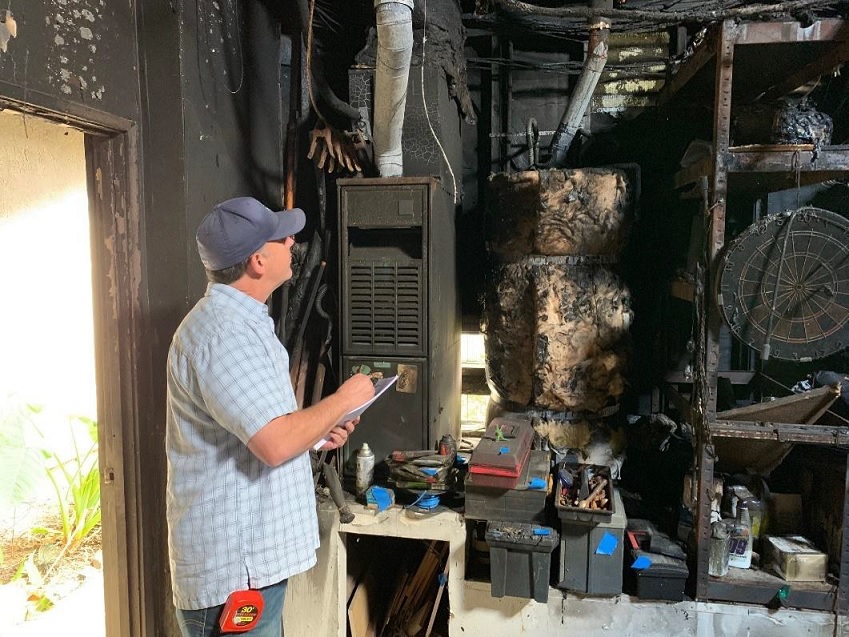 SAFETY STANDARDS FOR THE RESTORATION INDUSTRY
SAFETY STANDARDS FOR THE RESTORATION INDUSTRY
The Occupational Safety and Health Administration (OSHA) states that a hazardous substance is “any biological agent and other disease-causing agent which after release into the environment and upon exposure, ingestion, inhalation, or assimilation into any person…will or may reasonably be anticipated to cause death, disease, behavioral abnormalities, cancer, genetic mutation, physiological malfunctions…or physiological deformations in such persons or their offspring.” [97] It is abundantly clear that TCDD qualifies as a hazardous substance.
In a structure fire or wildfire environment, a respiratory hazard exists when a toxic contaminant is present in the air at a dangerous concentration. The damage may occur immediately, or it may take days, weeks, or even years for effects to surface. [98]
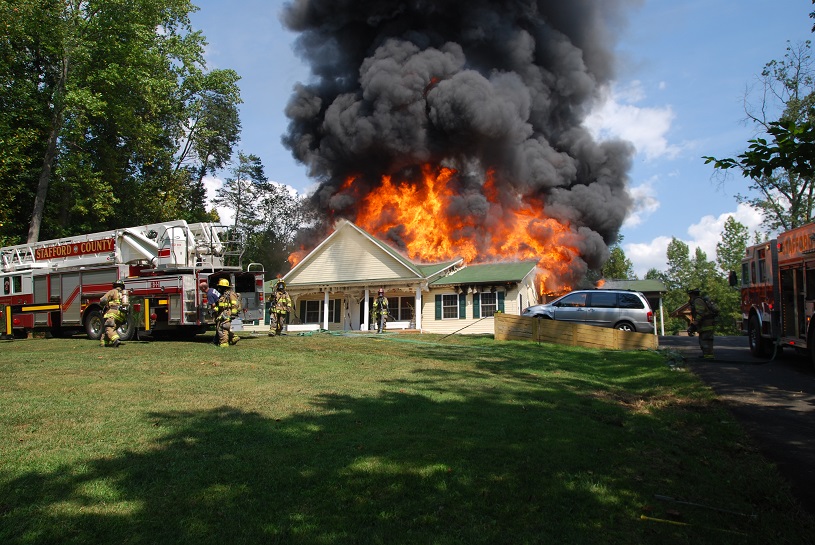
Assessment of Exposure to TCDD
The National Institute for Occupational Safety and Health (NIOSH) states: “Workers may be exposed to TCDD derived from a variety of sources. The first step in assessing workplace contamination should be environmental sampling to determine the presence of TCDD contamination, keeping in mind the possible routes of exposure (inhalation, absorption, and ingestion), with later sampling conducted to define the quantity of TCDD in the environment. The assessment may include sampling of soil and settled dust for TCDD, air sampling for TCDD- contaminated particles, and wipe sampling of surfaces.” [99]
Decontamination and Worker Protection Programs Regarding TCDD
The following information in italics was provided by NIOSH: “In general, decontamination procedures must provide an organized process in which levels of contamination are reduced. This requires containment, collection, and disposal of contaminated solutions and residues generated during the cleanup. Separate facilities should be provided for decontamination of large equipment. Each stage of decontamination, such as gross decontamination and repetitive wash/rinse cycles, should be conducted separately, either by using different locations or by spacing in time. Personnel decontamination locations used should be physically separated to prevent cross-contact and should be arranged in order of decreasing level of contamination. Separate entry/exit routes and locations should be provided for workers when it is necessary to isolate them from different contamination areas containing incompatible waste. Entry and exit points to these areas should be well marked and controlled. Access to the decontamination area should be separate from the path between the contaminated and clean areas. Dressing stations for entry should be separate from re-dressing areas for exit.” [100]
Protective Clothing and Equipment
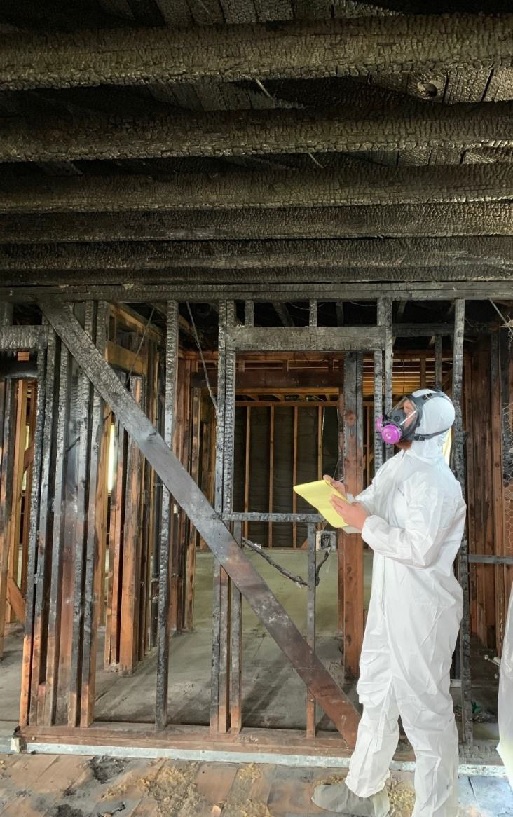 “All workers who may be exposed to TCDD should be equipped with adequate chemical protective clothing and equipment to ensure their protection. In the selection of protective clothing, consideration should be given to the utilization of disposable apparel due to the uncertainty of decontamination of clothing. The protective apparel should consist of both outer and inner garments. The outer garments should consist of a zippered coverall with attached hood and draw string or elastic sleeves, gloves and closure boots. If exposure is to particulate or dust, the coveralls should be made of a non-woven fabric such as spunbonded polyethylene, Tyvek®. In cases of exposure to liquids, the coveralls, gloves and boots should be made of chemically resistant materials such as disposable laminates, e.g., Saranax® coated Tyvek®, or synthetic elastomers such as butyl, nitrile or neoprene rubber. The inner garments should consist of cotton coveralls, undershirts, undershorts, gloves, and socks and should be disposed of after use. The effectiveness of the protective clothing should be evaluated under simulated use conditions, regardless of the type of clothing used. All disposable clothing should be placed in marked and approved containers and disposed of appropriately. All reusable clothing and equipment should be thoroughly cleaned and checked for residual contamination before reuse or storage.” [101]
“All workers who may be exposed to TCDD should be equipped with adequate chemical protective clothing and equipment to ensure their protection. In the selection of protective clothing, consideration should be given to the utilization of disposable apparel due to the uncertainty of decontamination of clothing. The protective apparel should consist of both outer and inner garments. The outer garments should consist of a zippered coverall with attached hood and draw string or elastic sleeves, gloves and closure boots. If exposure is to particulate or dust, the coveralls should be made of a non-woven fabric such as spunbonded polyethylene, Tyvek®. In cases of exposure to liquids, the coveralls, gloves and boots should be made of chemically resistant materials such as disposable laminates, e.g., Saranax® coated Tyvek®, or synthetic elastomers such as butyl, nitrile or neoprene rubber. The inner garments should consist of cotton coveralls, undershirts, undershorts, gloves, and socks and should be disposed of after use. The effectiveness of the protective clothing should be evaluated under simulated use conditions, regardless of the type of clothing used. All disposable clothing should be placed in marked and approved containers and disposed of appropriately. All reusable clothing and equipment should be thoroughly cleaned and checked for residual contamination before reuse or storage.” [101]
Respiratory Protection
“The use of respiratory protection requires that a respiratory protection program be instituted according to the requirements of 29 CFR 1910.134 and that the respirators have been approved by the Mine Safety and Health Administration (MSHA) and by NIOSH. This program should include training on proper fit testing and use and procedures for respirator maintenance, inspection, cleaning and evaluation. For situations where TCDD contamination is low (e.g., exposure to dust contaminated with low levels of TCDD), air purifying respirators should provide sufficient protection until the extent and characterization of the exposure can be determined. Where quantities of materials highly contaminated with TCDD have been released and have contaminated an area (e.g., production accidents), all workers who may be exposed to TCDD should wear respirators that consist of a self-contained breathing apparatus with a full facepiece operated in pressure-demand or other positive pressure mode. An alternate method utilizes a combination Type C supplied air respirator, with full facepiece, operated in pressure-demand mode and equipped with auxiliary positive pressure self-contained air supply.” [102]
Post-Decontamination Clearance Testing for TCDD
NIOSH states: “The adequacy of the decontamination effort should be determined by conducting follow-up sampling and analysis of the contaminated areas and protective equipment. This testing should be conducted as each area is decontaminated and after the entire facility has been cleaned”. [103]
OSHA, NIOSH, and ACGIH Guidelines
In terms of human exposure to the various compounds in post-fire environments, different organizations have studied and published different definitions of values and limits of exposure.
The three organizations that are used most frequently are NIOSH, OSHA, and the American Conference of Governmental Industrial Hygienists (ACGIH). NIOSH defines an Immediately dangerous to life or health (IDLH) atmosphere as “an atmospheric concentration of any toxic, corrosive or asphyxiant substance that poses an immediate threat to life or would cause irreversible or delayed adverse health effects or would interfere with an individual’s ability to escape from a dangerous atmosphere.” [104]
OSHA has also defined a limit known as a Permissible Exposure Limit (PEL). A PEL, as defined by OSHA, is “the maximum concentration to which the majority of healthy adults can be exposed over a 40-hour workweek without suffering adverse effects”. [105] Keep in mind that TCDD has no permissible exposure limit. [106] “An OSHA PEL (C) is a PEL ceiling limit and this is the maximum concentration that a person can be exposed to at any time, even for an instant.” TCDD does not have a PEL ceiling limit. [107]
The American Conference of Governmental Industrial Hygienists (ACGIH) has established Threshold Limit Values (TLVs ®) and Biological Exposure Indices (BEIs®). The TLV®, as defined by ACGIH, is an occupational exposure value recommendation which is believed nearly all workers can be exposed day after day for a working lifetime without ill effect. TLVs® and BEIs® are not standards. They are guidelines designed for use by industrial hygienists in making decisions regarding safe levels of exposure to various chemical substances and physical agents found in the workplace. In using these guidelines, industrial hygienists are cautioned that the TLVs® and BEIs® are only one of multiple factors to be considered in evaluating specific workplace situations and conditions. TLVs® and BEIs® are health-based values established by committees that review existing published and peer-reviewed literature in various scientific disciplines (e.g., industrial hygiene, toxicology, occupational medicine, and epidemiology).
No occupational exposure limits for TCDD were found in Canada or the ACGIH threshold limit value (TLV®). [108] There are a variety of other limits and values where a determination must be made with respect to the physical nature of the contaminant (vapor, gas, particulate), which ultimately allows the user to determine the maximum use concentration (MUC). The MUC is defined as the maximum atmospheric concentration of a hazardous substance from which an employee can be expected to be protected by a class of respirator. “No occupational exposure limits for TCDD were found in Canada or the ACGIH threshold limit value”
A NIOSH respirator selection logic sequence lists several steps to assist in respirator selection. This is to determine whether the respirator intended for entry into unknown or IDLH atmospheres is appropriate. If so, NIOSH only recommends using a self-contained breathing apparatus (SCBA) or a supplied air respirator. OSHA Regulation 29CFR1910.134 (2007) reads much the same as NIOSH with minor exceptions. One such exception is listed in the general requirements section and is identified as 29CFR1910.134 (d)(1)(iii). This section states: “The employer shall identify and evaluate the respiratory hazard(s) in the workplace; this evaluation shall include a reasonable estimate of employee exposures to respiratory hazard(s) and an identification of the contaminant’s chemical state and physical form. Where the employer cannot identify or reasonably estimate the employee exposure, the employer shall consider the atmosphere to be IDLH.”
Without comprehensive testing and sampling, there is no way to predetermine hazardous conditions or concentrations of toxic materials including TCDD in a fire environment. [109,110]
OSHA’s Permissible Exposure Limits are Outdated and Inadequate
The following was provided by OSHA: “OSHA recognizes that many of its permissible exposure limits (PELs) are outdated and inadequate for ensuring protection of worker health. Most of OSHA’s PELs were issued shortly after adoption of the Occupational Safety and Health (OSH) Act in 1970, and have not been updated since that time. Section 6(a) of the OSH Act granted the Agency the authority to adopt existing Federal standards or national consensus standards as enforceable OSHA standards. Most of the PELs contained in the Z-Tables of 29 CFR 1910.1000 were adopted from the Walsh-Healy Public Contracts Act as existing Federal standards for general industry. These in turn had been adopted from the 1968 Threshold Limit Values (TLVs®) of the American Conference of Governmental Industrial Hygienists (ACGIH®). Some consensus standards from the American Standards Association were also adopted at that time, following the 6(a) procedures. Comparable PELs were adopted for shipyards (29 CFR 1915.1000) and construction (29 CFR 1926.55).
Since 1970, OSHA promulgated complete 6(b) standards including new PELs for 16 agents, and standards without PELs for 13 carcinogens. Industrial experience, new developments in technology, and scientific data clearly indicate that in many instances these adopted limits are not sufficiently protective of worker health.
This has been demonstrated by the reduction in allowable exposure limits recommended by many technical, professional, industrial, and government organizations, both inside and outside the United States. Many large industrial organizations have felt obligated to supplement the existing OSHA PELs with their own internal corporate guidelines. OSHA’s Hazard Communication standard (1910. 1200 Appendix D) requires that safety data sheets list not only the relevant OSHA PEL but also the ACGIH® TLV® and any other exposure limit used or recommended by the chemical manufacturer, importer, or employer preparing the safety data sheet.” [111]
New NIOSH Policy
NIOSH states: “For the past 20 plus years, NIOSH has subscribed to a carcinogen policy that was published in 1976 by Edward J. Fairchild, II, Associate Director for Cincinnati Operations, which called for “no detectable exposure levels for proven carcinogenic substances” (Annals of the New York Academy of Sciences, 271:200-207, 1976). This was in response to a generic OSHA rulemaking on carcinogens. Because of advances in science and in approaches to risk assessment and risk management, NIOSH has adopted a more inclusive policy. NIOSH recommended exposure limits (RELs) will be based on risk evaluations using human or animal health effects data, and on an assessment of what levels can be feasibly achieved by engineering controls and measured by analytical techniques. To the extent feasible, NIOSH will project not only a no-effect exposure, but also exposure levels at which there may be residual risks. This policy applies to all workplace hazards, including carcinogens, and is responsive to Section 20(a)(3) of the Occupational Safety and Health Act of 1970, which charges NIOSH to “. . describe exposure levels that are safe for various periods of employment, including but not limited to the exposure levels at which no employee will suffer impaired health or functional capacities or diminished life expectancy as a result of his work experience.”
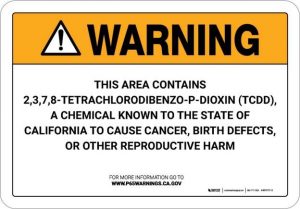 The effect of this new policy will be the development, whenever possible, of quantitative RELs that are based on human and/or animal data, as well as on the consideration of technological feasibility for controlling workplace exposures to the REL. Under the old policy, RELs for most carcinogens were non-quantitative values labeled “lowest feasible concentration (LFC).” Under the new policy, NIOSH will also recommend the complete range of respirators (as determined by the NIOSH Respirator Decision Logic) for carcinogens with quantitative RELs. In this way, respirators will be consistently recommended regardless of whether a substance is a carcinogen or a non-carcinogen.” [112]
The effect of this new policy will be the development, whenever possible, of quantitative RELs that are based on human and/or animal data, as well as on the consideration of technological feasibility for controlling workplace exposures to the REL. Under the old policy, RELs for most carcinogens were non-quantitative values labeled “lowest feasible concentration (LFC).” Under the new policy, NIOSH will also recommend the complete range of respirators (as determined by the NIOSH Respirator Decision Logic) for carcinogens with quantitative RELs. In this way, respirators will be consistently recommended regardless of whether a substance is a carcinogen or a non-carcinogen.” [112]
For a comprehensive list of studies done with TCDD, visit the Registry of Toxic Effects of Chemical Substances (RTECS) at https://www.cdc.gov/niosh-rtecs/HP3567E0.html
This list contains:
- Mutation Data and References
- Reproductive Effects Data and References
- Tumorigenic Data and References
- Acute Toxicity Data and References
- Other Multiple Dose Data and References
CONCLUSIONS & OPINIONS
RAISING AWARENESS
The term “hazardous material” is defined by OSHA in the Code of Federal Regulations Title 29 Section 1910.1200 as being any item or chemical which is a “health hazard” or “physical hazard”, including:
- Chemicals that are carcinogens, toxic or highly toxic agents, reproductive toxins, irritants, corrosives, hepatotoxins, nephrotoxins, neurotoxins, agents that act on the hematopoietic system, and agents that damage the lungs, skin, eyes, or mucous membranes;
- Chemicals that, in the course of normal handling, use or storage, may produce or release dusts, gases, fumes, vapors, mists or smoke having any of the above characteristics. [113] OSHA goes on to define the term “hazardous substance”, (including TCDD) defined as hazardous by the EPA and the U.S. Department of Transportation, which reads: “Any biological agent and other disease-causing agent which after release into the environment and upon exposure, ingestion, inhalation, or assimilation into any person…will or may reasonably be anticipated to cause death, disease, behavioral abnormalities, cancer, genetic mutation, physiological malfunctions…or physiological deformations in such persons or their offspring. As implied by the plain language of this definition, the phrase “other disease-causing agents” refers to any substance not otherwise covered under subparagraphs (A)-(D) of the definition, which causes death, disease, behavioral abnormalities, etc.” [114]
Given the extreme toxicity of TCDD and the vast array of other toxic substances, VOC’s, chemicals, and particulate matter in structure fire settings, it could be argued that only those with Hazardous Waste Operations and Emergency Response (HAZWOPER) certifications or hazardous material abatement companies should be allowed to enter or perform remediation, demolition, or cleanup work in post-fire environments. [115]
It is safe to say that most, if not all structure fire settings will have significant amounts of TCDD resulting from the combustion of chlorinated products such as PVC, paper, household chemicals, and other materials. Since federally regulated toxic substances such as lead, mercury, and asbestos pale in comparison to the toxicity of TCDD, local public health agencies, as well as on-scene public safety officials need to inform those affected by fires of the health risks of exposure to TCDD. Restoration, abatement, and hazardous material testing companies, industrial hygienists and others engaged in the fire restoration industry also play a vital role in raising awareness and reducing potential health risks of exposure to TCDD.
Since it has been established that there is no safe level of exposure to TCDD, the current culture of homeowners, disaster relief workers, insurance adjusters, contractors, restoration personnel, etc. who enter post-structure fire environments without wearing personal protective equipment must change. Anyone who needs to enter a fire damaged home, building, or area recently impacted by a wildfire should wear the most protective PPE, including a proper fitting respirator with P-100 filters (or a supplied air respirator), disposable coveralls, gloves, eye protection, etc.
AIR TESTING & SURFACE SAMPLING
As cited previously, the CDC and NIOSH recommend testing be performed to check for the presence and concentrations of TCDD. This would hold true especially in post-structure fire environments. This is a crucial step to safeguard workers as well as occupants who may enter a potentially contaminated area or structure. [116]
Testing should be conducted in similar fashion as to what is normally done in water damaged buildings where mold contamination exists. Here, industrial hygienists test the air and take surface samples to determine the concentrations and types of mold growth and/or spore counts that may be present. Then, once the test results are generated, a protocol is written that provides specific guidelines on how to remediate the contamination.
Since TCDD is a far greater health concern than mold, comprehensive surface and air testing in post-structure fire environments should be mandatory. How else can restoration practitioners properly protect their employees or take appropriate measures to remediate TCDD and restore buildings or homes to their pre-loss condition? Every structure fire has its own DNA, and no two fires are the same. Factors such as the types and quantities of materials that burned, the duration of the fire, and the intensity of the heat all play a role in determining the toxicity of the soot, ash, and particulate matter, as well as the methods of restoration. In most cases, the chemicals and gases created by the burning of everyday common household products and building materials creates some of the most toxic chemicals known to man.
Here are ten reasons why pre-remediation and post-restoration air and surface sampling testing is necessary and should be a standard practice in all fire and/or smoke restoration projects:
- Employee and occupant protection. OSHA regulation 1910.134(d)(1)(iii) states: “The employer shall identify and evaluate the respiratory hazard(s) in the workplace; this evaluation shall include a reasonable estimate of employee exposures to respiratory hazard(s) and an identification of the contaminant’s chemical state and physical form. Where the employer cannot identify or reasonably estimate the employee exposure, the employer shall consider the atmosphere to be immediately dangerous to life and health (IDLH).” This would apply to anyone who enters or works in a fire damage environment.
- OSHA regulation 1910.120(h)(1)(i) states: “Monitoring shall be performed in accordance with this paragraph where there may be a question of employee exposure to hazardous concentrations of hazardous substances in order to assure proper selection of engineering controls, work practices and personal protective equipment so that employees are not exposed to levels which exceed permissible exposure limits, or published exposure levels if there are no permissible exposure limits, for hazardous substances.”
- OSHA Section 1910.120(h)(1)(ii) states: “Air monitoring shall be used to identify and quantify airborne levels of hazardous substances and safety and health hazards in order to determine the appropriate level of employee protection needed on site.”
- OSHA Section 1910.120(h)(2) states: “Upon initial entry, representative air monitoring shall be conducted to identify any IDLH condition, exposure over permissible exposure limits or published exposure levels,…”
- OSHA has established limits of exposure to hazardous chemicals, including combustion byproducts known as permissible exposure limits (PEL’s). A comprehensive list of these chemicals can be found at https://www.dir.ca.gov/title8/5155table_ac1.html#_blank. Testing is necessary to determine if concentrations of TCDD, heavy metals, and/or other toxic chemicals are contained in the smoke or particulate matter. Although there is no set PEL for TCDD, testing is necessary for the health and safety of both workers and building occupants.
- Restorers need to know what types of VOC’s and chemicals they are dealing with to avoid incurring unnecessary costs of cleaning items or components that are unrestorable. Restorers also need to avoid creating unintentional toxic byproducts and chemical reactions when introducing cleaning agents or oxidizing gases. In some cases, building components and/or personal property may not be able to be properly cleaned with traditional techniques or cleansers. This includes materials or personal property affected by TCDD and other hazardous substances.
- TCDD is colorless, odorless, and can adsorb to particulate at microscopic levels. Testing is necessary to determine if TCDD is present in the particulate and/or absorbed into porous materials.
- Property owners and restorers should have an independent, third-party remediation protocol established to properly remediate TCDD and other combustion byproducts. This is consistent with what the restoration industry does for asbestos, lead, mold, and other types of hazardous substance remediation.
- Fire restoration training manuals, such as The Guidelines for Fire and Smoke Damage Repair provided by the Restoration Industry Association, recommend testing for toxic combustion byproducts (page 67).
- Once the remediation and cleaning have been completed, a clearance test needs to be performed prior to reconstruction that certifies that any TCDD concentrations and particulate matter have been successfully remediated and the indoor air quality has been restored. “The purpose of a post-remediation verification after fire and smoke damage is to determine the efficacy of cleaning fire-related combustion particles and residues from structural elements, finishing materials and/or personal items/contents within the designated work area(s). The post-remediation verification provides a measure of assurance, within the limitations of sampling, visual observations/olfactory perception and analysis, that the structure and contents have been remediated to a pre-loss condition.” 2017 Council Certified Fire and Smoke Damage Certification Program – American Council for Accredited Certification (pages 52-53)
TCDD has no permissible exposure limit, is far more toxic than lead, mercury, asbestos, or mold, and causes a vast array of health risks, not only to those exposed, but potentially to future generations. For these reasons alone, strict rules designed to protect the health of workers and occupants should be implemented for restoration or remediation work. At a minimum, OSHA guidelines for lead under Regulation 1926.62, found at https://www.osha.gov/laws-regs/regulations/standardnumber/1926/1926.62, should be followed.
OSHA has also issued additional guidelines titled Controlling Lead Exposures in the Construction Industry: Engineering and Work Practice Controls, which can be found at https://www.osha.gov/dts/osta/otm/otm_v/otm_v_3.html. These work practices should also be followed as a minimum requirement for the removal, remediation, and handling of materials contaminated with TCDD.
As discussed previously, 160 mg of TCDD can be generated by the combustion of only 1 kilogram (2.20 pounds) of wood. Adverse health effects from TCDD are measured in trillionths and sometimes quadrillionths of a gram, so it is safe to say that structure fires in general create large amounts of TCDD.
TEXTILE CONTAMINATION
 Currently there are no scientifically proven methods to clean textiles contaminated with TCDD. In fact, the only known way to destroy TCDD is by incinerating it at temperatures over 1,500 °F. TCDD is not water soluble, nor does it decompose when exposed to ozone or hydroxyl in the atmosphere. Therefore, any textiles (clothing, bedding, carpeting, rugs, or soft goods) that are contaminated with smoke vapors, particulate, or soot containing TCDD should be considered non-salvageable.
Currently there are no scientifically proven methods to clean textiles contaminated with TCDD. In fact, the only known way to destroy TCDD is by incinerating it at temperatures over 1,500 °F. TCDD is not water soluble, nor does it decompose when exposed to ozone or hydroxyl in the atmosphere. Therefore, any textiles (clothing, bedding, carpeting, rugs, or soft goods) that are contaminated with smoke vapors, particulate, or soot containing TCDD should be considered non-salvageable.
Seeing as TCDD is resistant to degradation or oxidation from ozone or hydroxyl, current smoke damage restoration and cleaning techniques for textiles contaminated with TCDD will most likely be ineffective.
In the restoration industry today, textiles that have been contaminated with hazardous materials such as asbestos, lead, meth lab chemicals, sewage, or mold are typically considered unrestorable. Given the extreme toxicity of TCDD and its ability to be absorbed by the skin, textiles (especially clothing), should not be cleaned or reused.
If an attempt is made to clean smoke damaged textiles that are contaminated with TCDD, heavy metals, or other toxic combustion byproducts, then samples of the articles should be analyzed after the cleaning by a qualified independent third-party laboratory to see if the cleaning was truly successful. This is particularly important for clothing, where TCDD and other toxic combustion byproducts can come in contact with the skin and be absorbed.
For those in the fire service, turnout coats, trousers, and other protective garments are regularly exposed to high concentrations of toxic substances, including TCDD. Although some fire departments use industrial grade washing machines and detergents to clean their gear, periodic testing should be performed to verify if these cleaning methods are effective, or if hazardous substances, such as TCDD remain embedded in the fabric after cleaning.
Each year, new materials and chemicals are being created and introduced to consumers in the form of building materials and household products. Most of which are destined to create vast arrays of known and unknown toxic substances when burned. Fire restoration practitioners need to know what is restorable and what is not before attempts are made or money is spent on restoration efforts. Restorers also need to realize that certain materials contaminated by toxic substances in structure fire smoke simply cannot be cleaned.
For information on testing for TCDD in textiles or buildings, contact Bruce Rosenblatt with Rarefied Air Environmental at 619-888-4840 or visit: https://rarefiedairenvironmental.com
How Dioxin Damages the Human Body
Dioxin! What Citizens, Workers and Policymakers Should Know
SOURCES:
- Wood Smoke is Rich in Dioxins and PCBs http://burningissues.org/car-www/pdfs/DioxonFlier.pdf
- The Business Mirror – This toxic chemical called Dioxin https://businessmirror.com.ph/2018/09/06/this-toxic-chemical-called-dioxin/
- World Health Organization – Dioxins and their effects on human health https://www.who.int/news-room/fact-sheets/detail/dioxins-and-their-effects-on-human-health
- United Nations Stockholm Convention – The 12 initial POPs under the Stockholm Convention http://chm.pops.int/TheConvention/ThePOPs/The12InitialPOPs/tabid/296/Default.aspx
- World Health Organization – Persistent organic pollutants (POPs) https://www.who.int/foodsafety/areas_work/chemical-risks/pops/en/
- EPA – Persistent Organic Pollutants: A Global Issue, A Global Response https://www.epa.gov/international-cooperation/persistent-organic-pollutants-global-issue-global-response
- The Center for Health, Environment & Justice – The American People’s Dioxin Report http://chej.org/wp-content/uploads/American%20Peoples%20Dioxin%20Report.pdf
- World Health Organization – Dioxins and their effects on human health https://www.who.int/news-room/fact-sheets/detail/dioxins-and-their-effects-on-human-health
- EPA – Wastes – Non-Hazardous Waste – Municipal Solid Waste https://archive.epa.gov/epawaste/nonhaz/municipal/web/html/health.html
- World Health Organization – Dioxins and their effects on human health http://www.who.int/mediacentre/factsheets/fs225/en/
- National Toxicology Program, Department of Health and Human Services – Report on Carcinogens, Fourteenth Edition – 2,3,7,8-Tetrachlorodibenzo-p-dioxin CAS No. 1746-01-6 https://ntp.niehs.nih.gov/ntp/roc/content/profiles/tetrachlorodibenzodioxin.pdf
- EPA – Wastes – Non-Hazardous Waste – Municipal Solid Waste https://archive.epa.gov/epawaste/nonhaz/municipal/web/html/health.html
- EPA – Dioxins Produced by Backyard Burning https://www.epa.gov/dioxin/dioxins-produced-backyard-burning
- Centers for Disease Control – Public Health Statement
- Chlorinated Dibenzo-P-Dioxins https://www.atsdr.cdc.gov/ToxProfiles/tp104-c1-b.pdf (page 6 – Sect. 1.4)
- Centers for Disease Control and The National Institute for Occupational Safety and Health (NIOSH) https://www.cdc.gov/niosh/npg/npgd0594.html
- U.S. National Library of Medicine – National Center for Biotechnology – Compound Summary for
2,3,7,8-Tetrachlorodibenzo-P-dioxin https://pubchem.ncbi.nlm.nih.gov/compound/15625#section=GHS-Classification - Agency for Toxic Substances and Disease Registry https://www.atsdr.cdc.gov/ToxProfiles/tp104-c7.pdf
- ALS Life Sciences Europe https://www.alsglobal.eu/specialities/dioxins-testing/dioxin-testing/about-dioxins
- U.S. National Library of Medicine – National Institutes of Health https://www.ncbi.nlm.nih.gov/pubmed/21183436
- Healing the Harm: Eliminating the Pollution from Health Care Practices, Health Care Without Harm Campaign Report, 1997; and Huff, 1994.
- U.S. National Library of Medicine – National Institutes of Health https://www.ncbi.nlm.nih.gov/pubmed/10794914
- Clean Air Revival, Inc. http://burningissues.org/car-www/medical_effects/dioxin.htm
- U.S. National Library of Medicine – National Institutes of Health
https://www.ncbi.nlm.nih.gov/pmc/articles/PMC2788749/ - Why is Dioxin So Dangerous? By: Don Fitz, Gateway Green Alliance http://www.greens.org/s-r/078/07-06.html
- U.S. National Library of Medicine – National Institutes of Health https://www.ncbi.nlm.nih.gov/pubmed/20083559
- Birnbaum, Linda et al. Developmental Effects of Dioxins and Related Endocrine Disrupting Chemicals. Experimental Toxicology Division, U.S. EPA. Toxicology Letters, p. 743-750,1995.
- International Agency for Research on Cancer (IARC) of the World Health Organizations, United Nations, 1997. National Toxicology Program Board of Scientific Counselors of the National Institute of Environmental Health Sciences, 1997.
- United States General Accounting Office – Report to Congressional Requesters – April 2002 Environmental Health Risks Information on EPA’s Draft Reassessment of Dioxins https://www.gao.gov/new.items/d02515.pdf (page 30)
- New Jersey Department of Health and Senior Services – Hazardous Substance Fact Sheet – 2,3,7,8-tetrachlorodibenzo-p-dioxin https://nj.gov/health/eoh/rtkweb/documents/fs/1806.pdf
- Health Risks From Dioxin and Related Compounds – National Research Council. 2006. Health Risks from Dioxin and Related Compounds: Evaluation of the EPA Reassessment. Washington, DC: The National Academies Press. https://doi.org/10.17226/11688
- The Aspen Institute https://www.aspeninstitute.org/programs/agent-orange-in-vietnam-program/health-effects/
- New Jersey Department of Health and Senior Services – Hazardous Substance Fact Sheet – 2,3,7,8-tetrachlorodibenzo-p-dioxin https://nj.gov/health/eoh/rtkweb/documents/fs/1806.pdf
- National Institute of Environmental Health Sciences – Dioxins https://www.niehs.nih.gov/health/topics/agents/dioxins/index.cfm
- National Cancer Institute https://www.cancer.gov/publications/dictionaries/cancer-terms/def/mutagen
- National Institute of Environmental Health Sciences – Dioxin exposure causes transgenerational health effects https://factor.niehs.nih.gov/2012/11/science-dioxin/index.htm
- National Institute of Environmental Health Sciences – Dioxins https://www.niehs.nih.gov/health/topics/agents/dioxins/index.cfm
- National Center for Biotechnology Information https://www.ncbi.nlm.nih.gov/pmc/articles/PMC3458876/
- Adverse Effects in Adulthood Resulting From Low-Level Dioxin Exposure in Juvenile Zebrafish by: Tracie R Baker, Richard E Peterson &Warren Heideman https://www.tandfonline.com/doi/full/10.4161/endo.28309
- National Institute of Environmental Health Sciences – Dioxins https://www.niehs.nih.gov/health/topics/agents/dioxins/index.cfm
- National Institute of Environmental Health Sciences – Dioxins https://www.niehs.nih.gov/health/topics/agents/dioxins/index.cfm
- The Aspen Institute https://www.aspeninstitute.org/programs/agent-orange-in-vietnam-program/health-effects/
- Science Direct – Dioxin https://www.sciencedirect.com/topics/medicine-and-dentistry/dioxin
- U.S. National Library of Medicine – National Center for Biotechnology Information – 2,3,7,8-tetrachlorodibenzo-p-dioxin https://pubchem.ncbi.nlm.nih.gov/compound/2_3_7_8-Tetrachlorodibenzo-P-dioxin
- Environmental Exposure to Endocrine-disrupting Chemicals and Miscarriage by: Sacha A. Krieg, M.D., Ph.D., Lora K. Shahine, M.D., and Ruth B. Lathi, M.D. https://www.fertstert.org/article/S0015-0282(16)61398-5/pdf
- U.S. National Library of Medicine National Institutes of Health – “Recent advances in understanding the mechanisms of TCDD immunotoxicity” https://www.ncbi.nlm.nih.gov/pubmed/11811931
- US National Library of Medicine – National Institutes of Health – “Immunological effects of chlorinated dibenzo-p-dioxins” https://www.ncbi.nlm.nih.gov/pmc/articles/PMC1518816/
- U.S. National Library of Medicine – National Center for Biotechnology Information – 2,3,7,8-tetrachlorodibenzo-p-dioxin https://pubchem.ncbi.nlm.nih.gov/compound/2_3_7_8-Tetrachlorodibenzo-P-dioxin
- U.S. National Library of Medicine – National Institutes of Health – “An Overview of the Effects of Dioxins and Dioxin-like Compounds on Vertebrates, as Documented in Human and Ecological Epidemiology” by: Sally S. White and Linda S. Birnbaum https://www.ncbi.nlm.nih.gov/pmc/articles/PMC2788749/
- Wikipedia – Neurotoxicity https://en.wikipedia.org/wiki/Neurotoxicity
- U.S. National Library of Medicine – National Center for Biotechnology Information – 2,3,7,8-tetrachlorodibenzo-p-dioxin https://pubchem.ncbi.nlm.nih.gov/compound/2_3_7_8-Tetrachlorodibenzo-P-dioxin#section=Exposure-Control-and-Personal-Protection
- The Centers for Disease Control and Prevention – The National Institute for Occupational Safety and Health – 2,3,7,8 -Tetrachlorodibenzo-p-dioxin (TCDD, “dioxin”) https://www.cdc.gov/niosh/docs/84-104/default.html Sixth Biennial Report on Great Lakes Water Quality, Washington, D.C. and Ottawa, Ontario: International Joint Commission, 1992.
- World Health Organization – “Dioxins and their effects on human health”
https://www.who.int/en/news-room/fact-sheets/detail/dioxins-and-their-effects-on-human-health - US National Library of Medicine – National Institutes of Health – “Dioxins levels in human blood after implementation of measures against dioxin exposure in Japan” by: Basilua Andre Muzembo, Miyuki Iwai-shimada, Tomohiko Isobe, Kokichi Arisawa, Masayuki Shima, Tetsuhito Fukushima, and Shoji F. Nakayama corresponding author https://www.ncbi.nlm.nih.gov/pmc/articles/PMC6329082/
- Washington State Department of Ecology – “Hazards of Dioxins” https://fortress.wa.gov/ecy/publications/documents/0104010.pdf
- Agency for Toxic Substances and Disease Registry – “Potential for Human Exposure” https://www.atsdr.cdc.gov/toxprofiles/tp104-c5.pdf
- United States General Accounting Office – Report to Congressional Requesters – April 2002 Environmental Health Risks Information on EPA’s Draft Reassessment of Dioxins (page 5) https://www.gao.gov/new.items/d02515.pdf
- BusinessMirror – “This Toxic Chemical Called Dioxin” By Henrylito D. Tacio September 6, 2018
https://businessmirror.com.ph/2018/09/06/this-toxic-chemical-called-dioxin/ - “Why is Dioxin So Dangerous?” By: Don Fitz, Gateway Green Alliance http://www.greens.org/s-r/078/07-06.html
- United States General Accounting Office – Report to Congressional Requesters – April 2002 Environmental Health Risks Information on EPA’s Draft Reassessment of Dioxins (page 29) https://www.gao.gov/new.items/d02515.pdf
- Agency for Toxic Substances and Disease Registry – “Chlorinated Dibenzo-P-Dioxins” https://www.atsdr.cdc.gov/toxfaqs/tfacts104.pdf
- Science Direct – Dioxin https://www.sciencedirect.com/topics/medicine-and-dentistry/dioxin
- Centers for Disease Control and Prevention – “Dioxin Toxicity” https://stacks.cdc.gov/view/cdc/7631
- National Center for Biotechnology Information – U.S. National Library of Medicine – “Veterans and Agent Orange – Update 2000” https://www.ncbi.nlm.nih.gov/books/NBK223402/
- Washington State Department of Ecology – “Hazards of Dioxins” https://fortress.wa.gov/ecy/publications/documents/0104010.pdf
- United States General Accounting Office – Report to Congressional Requesters – April 2002 Environmental Health Risks Information on EPA’s Draft Reassessment of Dioxins (page 4) https://www.gao.gov/new.items/d02515.pdf
- Science Direct – “Dioxin” https://www.sciencedirect.com/topics/medicine-and-dentistry/dioxin
- U.S. Environmental Protection Agency – “Learn About Dioxin” https://www.epa.gov/dioxin/learn-about-dioxin
- Substance and Perceptions of Environmental Impacts of Dioxin Emissions by: Panagiotis G. Deriziotis http://www.seas.columbia.edu/earth/wtert/sofos/Deriziotis_thesis_final.pdf
- Agency For Toxic Substances and Disease Registry – “Public Health Statement Chlorinated Dibenzo-P-Dioxins (CDDs)” page 3 https://www.atsdr.cdc.gov/ToxProfiles/tp104-c1-b.pdf
- World Health Organization – “Dioxins and their effects on human health https://www.who.int/news-room/fact-sheets/detail/dioxins-and-their-effects-on-human-health
- Washington State Department of Ecology – “Hazards of Dioxins” https://fortress.wa.gov/ecy/publications/documents/0104010.pdf
- Clean Air Revival – “Medical Effects: Dioxin and PCB’s From Wood Burning”
- New York State Department of Health – “Does Burning Trash Make it Disappear?” https://www.health.ny.gov/environmental/outdoors/air/trash.htm
- Environmental Science and Technology – “Emissions of Polychlorinated Dibenzo-p-dioxins and Polychlorinated Dibenzofurans from the Open Burning of Household Waste in Barrels” by: Paul M. Lemieux, Christopher C. Lutes, Judith A. Abbott, Kenneth M. Aldous https://www.pca.state.mn.us/sites/default/files/research-lemieux2000.pdf
- New York State Department of Health – “Does Burning Trash Make it Disappear?” https://www.health.ny.gov/environmental/outdoors/air/trash.htm
- U.S. National Library of Medicine – National Institutes of Health “An Overview of the Effects of Dioxins and Dioxin-like Compounds on Vertebrates, as Documented in Human and Ecological Epidemiology” by: Sally S. White and Linda S. Birnbaum https://www.ncbi.nlm.nih.gov/pmc/articles/PMC2788749/
- Gateway Green Alliance – Don Fitz http://www.greens.org/s-r/078/07-06.html
- History.com – “Agent Orange” https://www.history.com/topics/vietnam-war/agent-orange-1
- History.com – “Agent Orange” https://www.history.com/topics/vietnam-war/agent-orange-1
- National Center for Biotechnology Information – U.S. National Library of Medicine – “Veterans and Agent Orange – Update 2000” https://www.ncbi.nlm.nih.gov/books/NBK223402/
- News.com.au “Vietnam’s horrific legacy: The children of Agent Orange” by: Ash Anand https://www.news.com.au/world/asia/vietnams-horrific-legacy-the-children-of-agent-orange/news-story/c008ff36ee3e840b005405a55e21a3e1
- Centers for Disease Control and Prevention – The National Institute for Occupational Safety and Health https://www.cdc.gov/niosh-rtecs/HP3567E0.html
- Centers for Disease Control and Prevention – The National Institute for Occupational Safety and Health https://www.cdc.gov/niosh-rtecs/HP3567E0.html
- The Agency for Toxic Substances and Disease Registry, TOXICOLOGICAL PROFILE FOR 2,3,7,8-TETRACHLORODIBENZO-P-DIOXIN 1989 report Section 9.2.3.3 Carcinogenic potency, methods used by other agencies (page 95)
- Agency For Toxic Substances and Disease Registry https://www.atsdr.cdc.gov/ToxProfiles/tp104-c7.pdf
- National Center for Biotechnology Information – “Dioxins and Dioxin-like Compounds in the Food Supply: Strategies to Decrease Exposure.” https://www.ncbi.nlm.nih.gov/books/NBK221715/
- United States General Accounting Office – Report to Congressional Requesters – April 2002 Environmental Health Risks Information on EPA’s Draft Reassessment of Dioxins (page 29) https://www.gao.gov/new.items/d02515.pdf
- Centers for Disease Control and Prevention – The National Institute for Occupational Safety and Health https://www.cdc.gov/niosh/idlh/7439921.html
- Environmental Protection Agency – Fact Sheet – “Polychlorinated Dibenzo-p-dioxins and Related Compounds Update: Impact on Fish Advisories” https://www.epa.gov/sites/production/files/2018-11/documents/polychlorinated-impact-fish-advisories-factsheet.pdf
- United States General Accounting Office – Report to Congressional Requesters – April 2002 Environmental Health Risks Information on EPA’s Draft Reassessment of Dioxins (page 5) https://www.gao.gov/new.items/d02515.pdf
- Centers for Disease Control and Prevention – The National Institute for Occupational Safety and Health https://www.cdc.gov/niosh/docs/84-104/default.html
- Centers for Disease Control and Prevention – The National Institute for Occupational Safety and Health https://www.cdc.gov/niosh/docs/84-104/default.html
- The Vinyl Institute https://www.vinylinfo.org/uses/building-and-construction/
- U.S. National Library of Medicine National Institutes of Health – Mercury transformation and distribution across a polyvinyl chloride (PVC) production line in China https://www.ncbi.nlm.nih.gov/pubmed/24428761
- “Lead and Cadmium in Children’s Vinyl Products” By: Joseph Di Gangi PhD http://pvcinformation.org/assets/pdf/PbCdChildrenProducts.pdf
- International Association of Fire Chiefs – “America Burning: It’s Giving Us Cancer”, June 4, 2018 by: Chief Nathan Trauernicht https://www.iafc.org/iCHIEFS/iCHIEFS-article/america-burning-its-giving-us-cancer
- OSHA Standard 1910.120 https://www.osha.gov/laws-regs/standardinterpretations/1996-11-07
- New York State Department of Health – “What You Know Can Help You – An Introduction to Toxic Substances” https://www.health.ny.gov/environmental/chemicals/toxic_substances.htm
- Centers for Disease Control and Prevention – The National Institute for Occupational Safety and Health https://www.cdc.gov/niosh/docs/84-104/default.html
- Centers for Disease Control and Prevention – The National Institute for Occupational Safety and Health https://www.cdc.gov/niosh/docs/84-104/default.html
- Centers for Disease Control and Prevention – The National Institute for Occupational Safety and Health https://www.cdc.gov/niosh/docs/84-104/default.html
- Centers for Disease Control and Prevention – The National Institute for Occupational Safety and Health https://www.cdc.gov/niosh/docs/84-104/default.html
- OSHA – Standard Interpretations Response to IDLH or Potential IDLH atmospheres. Standard Number: 1910.134(g) 1910.120 1910.156 https://www.osha.gov/laws-regs/standardinterpretations/1995-05-01-2
- Centers for Disease Control and Prevention – The National Institute for Occupational Safety and Health https://www.cdc.gov/niosh/npg/npgd0594.html
- Centers for Disease Control and Prevention – The National Institute for Occupational Safety and Health https://www.cdc.gov/niosh/docs/84-104/default.html
- Centers for Disease Control and Prevention – The National Institute for Occupational Safety and Health https://www.cdc.gov/niosh/docs/84-104/default.html
- Carex Canada – 2,3,7,8-Tetrachlorodibenzo-para-dioxin Profile https://www.carexcanada.ca/profile/tcdd/
- European Fire Fighters Unions Alliance “Air Quality After The Fire” by: Greg A. Wyant http://www.effua.org/wp-content/uploads/2017/09/air_quality_after_the_fire.pdf
- Centers for Disease Control and Prevention – The National Institute for Occupational Safety and Health Derivation of Immediately Dangerous to Life or Health (IDLH) Values https://www.cdc.gov/niosh/docs/2014-100/pdfs/2014-100.pdf?id=10.26616/NIOSHPUB2014100
- OSHA – Permissible Exposure Limits – Annotated Tables https://www.osha.gov/dsg/annotated-pels/
- Centers for Disease Control and Prevention – The National Institute for Occupational Safety and Health Appendix A – NIOSH Potential Occupational Carcinogens https://www.cdc.gov/niosh/npg/nengapdxa.html
- U.S. General Services Administration – Hazardous Materials Management (HAZMAT) https://www.gsa.gov/buying-selling/purchasing-programs/requisition-programs/gsa-global-supply/supply-standards/hazardous-materials-management-hazmat
- OSHA – Standard Interpretations Definition of a Hazardous Substance https://www.osha.gov/laws-regs/standardinterpretations/1996-11-07
- OSHA – Frequently Asked Questions: HAZWOPER https://www.osha.gov/html/faq-hazwoper.html
- Centers for Disease Control and Prevention – The National Institute for Occupational Safety and Health https://www.cdc.gov/niosh/docs/84-104/default.html
Additional resources on TCDD can be found at the following sites:
https://journals.plos.org/plosone/article?id=10.1371/journal.pone.0045054
https://www.ncbi.nlm.nih.gov/pmc/articles/PMC2475945/
https://cfpub.epa.gov/ncea/risk/recordisplay.cfm?deid=54886
https://ntp.niehs.nih.gov/ntp/htdocs/lt_rpts/tr531.pdf
DISCLAIMER:
This paper is distributed as a public service for informational purposes only. While reasonable efforts were made to ensure the completeness and accuracy of its contents when published, no warranties or guarantees are made with respect to the completeness or accuracy of the information and opinions stated herein. The information and opinions stated herein may not be applicable to or suitable for every individual or situation and constitute the opinions of the Author and the sources of the information sited. Neither the Author nor Heritage Publishing & Communications, Ltd., shall be responsible to any user of the information for any injury, loss or damage of any kind or nature whatsoever that may be sustained as a consequence of the use and application of any information or opinions presented. In no event shall the Author nor Heritage Publishing & Communications, Ltd., be liable for any action taken or not taken by any person in reliance, directly or indirectly, upon the information and opinions provided herein. This publication is provided with the understanding that the Author, is not engaged in rendering legal advice and no legal opinions are provided by the Author. If legal or other professional advice or expert assistance is required, the services of a competent professional should be obtained.
All persons and entities using the information and opinions provided herein do so at their own risk and they hereby waive any and all claims against the Author and Heritage Publishing & Communications, Ltd. Such waiver includes any and all claims arising in contract or tort, and all forms of equitable relief and damages including without limitation compensatory, general, special, and consequential damages.
Without limiting any other disclaimer provided herein, under no circumstances shall the Author be liable for any injury, loss, or damage of any kind or nature whatsoever. Information in this newsletter relates to a subject that changes periodically due to changes in industry practices, science, and technology. All users of this paper acknowledge this disclaimer and agree to the limitations of liability stated above.
Do not use this information if you do not agree with this disclaimer and its limitations of liability as reasonable. If any portion of this disclaimer is found to be unenforceable under applicable law, the remainder of the disclaimer will remain enforceable.
ABOUT SEAN SCOTT:
 Mr. Scott is a licensed general contractor in the State of California who has spent over 39 years in the construction and restoration industry. As a second-generation fire and flood restoration contractor, he has been involved with literally thousands of property damage claims ranging from commercial and residential floods and fires, smoke claims, mold contamination, subsidence and earthquake claims, explosions, vehicular collisions, and many other types of property damaging incidents. Throughout his career, Sean has worked with all the major insurance carriers that underwrite residential and commercial policies and has worked directly with claims adjusters, independent adjusters, third party administrators, public adjusters, and attorneys.
Mr. Scott is a licensed general contractor in the State of California who has spent over 39 years in the construction and restoration industry. As a second-generation fire and flood restoration contractor, he has been involved with literally thousands of property damage claims ranging from commercial and residential floods and fires, smoke claims, mold contamination, subsidence and earthquake claims, explosions, vehicular collisions, and many other types of property damaging incidents. Throughout his career, Sean has worked with all the major insurance carriers that underwrite residential and commercial policies and has worked directly with claims adjusters, independent adjusters, third party administrators, public adjusters, and attorneys.
Sean is also the author of two books, The Red Guide to Recovery – Resource Handbook for Disaster Survivors and Secrets of the Insurance Game and the co-author of a third book titled The Native Family Disaster Preparedness Handbook.
Sean has devoted his life to assisting individuals and families rebuild their homes, businesses, and lives and has witnessed first-hand the physical, emotional, and financial challenges people face once the first responders leave the scene. Since 2009, Sean’s award-winning book The Red Guide to Recovery has been adopted by fire departments, emergency management agencies, and relief organizations across the U.S.
Sean now uses his time and expertise to help people navigate the recovery process, speak on recovery and restoration topics, and consult with those in the restoration industry who need guidance to be more successful. He also provides expert witness testimony, estimating services on property damage claims, insurance claim appraisal and umpire services, construction defect investigation, and training.
For more information on disaster restoration and recovery, The Red Guide to Recovery – Resource Handbook for Disaster Survivors and Secrets of The Insurance Game both provide a wealth of insight and information on the recovery process.

For more information, contact Sean Scott
Office: 858-453-6767
Cell: 858-349-2262
Email: Sean@TheRedGuideToRecovery.com
Website: TheRedGuideToRecovery.com
©Copyright Heritage Publishing & Communications, Ltd. All Rights Reserved 2018
